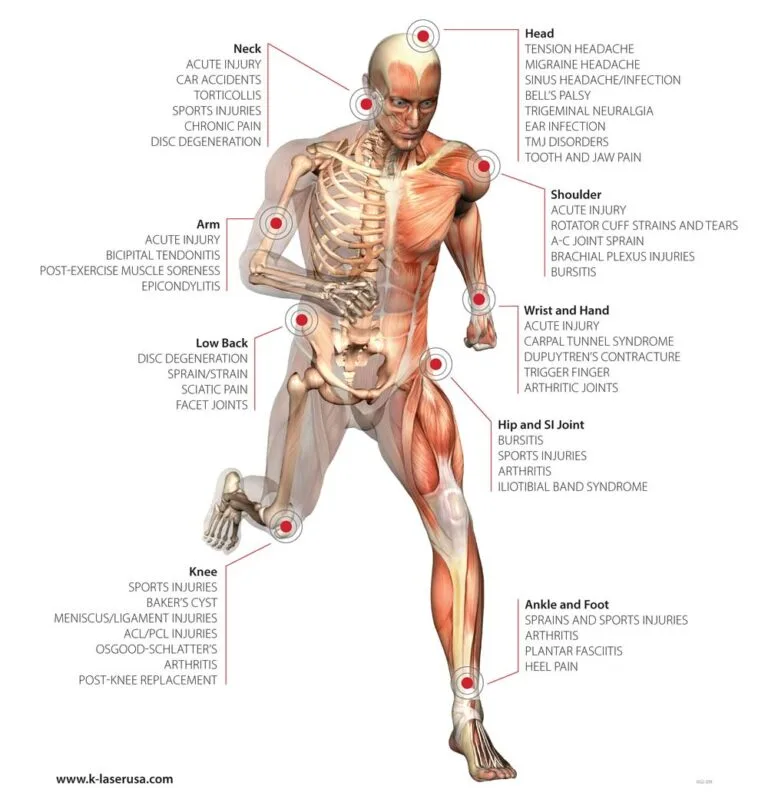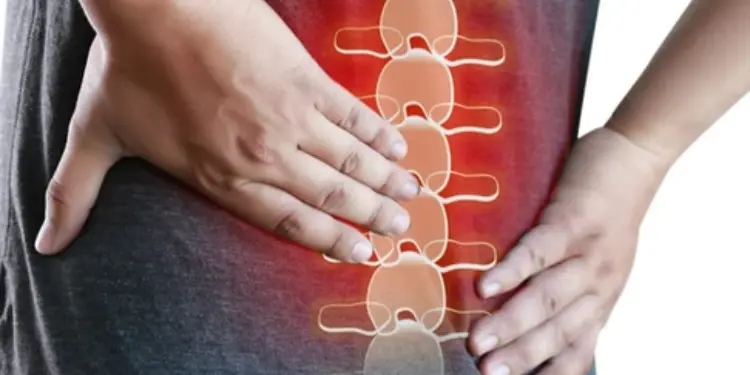Trigger points in Lower back and hip pain can disrupt your daily life, making even simple tasks feel challenging. These pains often stem from trigger points—tight areas within your muscles that cause discomfort. Understanding how to ease these trigger points can bring significant pain relief and enhance your overall quality of life.
Key Takeaways
- Trigger points, or muscle knots, can be a significant source of pain in the lower back and hip.
- Common symptoms of trigger points include muscle stiffness, aching, and shooting pain.
- Effective stretches and massage techniques can help relieve trigger points.
- Maintaining good posture and staying active can prevent the development of trigger points.
- Consulting a healthcare professional is crucial if pain persists or worsens.
Understanding Trigger Points in the Lower Back and Hip
What Are Trigger Points?
Small, sensitive muscle areas known as trigger points can radiate pain to different parts of your body. These spots are often called “knots” and can be very painful when touched. Trigger points can make your muscles feel tight and sore. They can also cause headaches and other types of pain.
Common Symptoms of Trigger Points
- Pain in the lower back or hip
- Muscle stiffness
- Limited range of motion
- Tingling or numbness
- Headaches
How Trigger Points Develop
Trigger points can develop from various causes, including:
- Muscle overuse: Doing the same movement repeatedly can strain your muscles.
- Injury: A sudden injury can lead to the formation of trigger points.
- Poor posture: Sitting or standing incorrectly can put stress on your muscles.
- Stress: Emotional stress may result in muscle tightness, which can develop into trigger points.
Understanding the differences and how trigger points, acupressure, and acupuncture work together can help manage pain effectively.
Identifying the Muscles Affected by Trigger Points

Understanding which muscles are affected by trigger points is crucial for effective treatment. Trigger points can cause pain and limit movement, so knowing the key muscles involved helps target the right areas for relief.
Key Muscles in the Lower Back

The lower back is supported by several important muscles that can develop trigger points:
- Erector Spinae: Running alongside the spine, these muscles support the spine, aiding in posture and movement.
- Quadratus Lumborum: These muscles on either side of the lower back play a vital role in stabilizing the spine.
- Multifidus: These small muscles are deep in the spine and help with fine-tuning movements.
Key Muscles in the Hip

The hip area also contains several muscles that are prone to trigger points:
- Gluteus Maximus: This major buttock muscle is essential for movement and structural stability.
- Piriformis: This small muscle helps rotate the hip and can cause sciatic pain when tight.
- Iliopsoas: A deep muscle that spans from the lower back to the hip, essential for leg lifting.
How These Muscles Interact
The muscles in the lower back and hip work together to support movement and stability. When one muscle develops a trigger point, it can affect the others, leading to a chain reaction of pain and discomfort. Understanding this interaction is critical to effective treatment and relief.
Effective Stretches for Relieving Trigger Points
Stretching Techniques for the Lower Back
Stretching the lower back can help ease tension and improve flexibility. One effective exercise is the Cat-Cow Pose. Start on your hands and knees, with shoulders above hands and hips above knees. Arch your back upward like a cat, hold for ten seconds, then dip it down like a cow, lifting your head and tailbone. Repeat three times.

Stretching Techniques for the Hip
Hip circles are a great way to increase flexibility and relieve tension in the hips. Position your feet shoulder-width apart and gently move your hips in circular patterns. This exercise effectively loosens the lower back and hip muscles. Another useful stretch is the knees-to-chest exercise. Lie on your back, pull your knees toward your chest, and hold for 20 seconds.

Combining Stretches for Maximum Relief
Combining stretches can provide maximum relief. For example, follow up with the Cat-Cow Pose after doing hip circles to target both the lower back and hips. This combination can help loosen tight muscles and improve overall mobility. Remember, consistency is critical. Stretching should be part of your daily routine to see the best results.
Massage Techniques to Alleviate Trigger Points
Self-Massage Methods
Self-massage can be a great way to ease trigger points in your lower back and hip. Simple tools like tennis balls or foam rollers can make a big difference. Here’s a quick guide to get you started:
- Lie on your back on a mat, positioning two tennis balls under your mid-back, with one ball on either side of your spine.
- Keep your knees bent and your feet flat on the ground.
- Move yourself gently up and down so that the tennis balls roll across your lower back.
- Adjust the pressure by moving your legs to relieve or increase the pressure from the tennis balls.
You can also use a foam roller:
- Place it below your lower back while lying face up on a mat.
- Apply pressure to the roller to target the source of your back pain.
- Moving the foam roller above or below the painful area can help alleviate discomfort.
Professional Massage Options
Sometimes, it’s best to leave it to the pros. Here are some types of professional massages that can help with trigger points:
- Therapeutic Massage: Targets specific areas to relieve discomfort and pain.
- Deep Tissue Massage: Uses more force to reach deeper muscles and connective tissues.
- Swedish Massage: Gentler, with long, circular movements and kneading.
- Sports Massage: Geared toward athletes to prevent injury or help recovery.
- Shiatsu Massage: A Japanese style using rhythmic pressure to stimulate self-healing.
Tools and Equipment for Self-Massage
Using the right tools can make self-massage more effective. Here are some you might find helpful:
- Lacrosse Ball: Great for pinpointing and releasing tight spots.
- Foam Roller: Ideal for larger muscle groups and overall muscle relaxation.
- Massage Stick: Useful for rolling out tension in the legs and back.
Keep in mind that trigger point therapy interrupts pain cycles, enhances blood flow, and restores muscle balance. It might feel terrible initially, but the benefits are worth it.
By incorporating these techniques and tools into your routine, you can effectively manage and alleviate trigger points in your lower back and hip.
Lifestyle Changes to Prevent Trigger Points
Ergonomic Adjustments
Making small changes to your workspace can significantly impact your back and hip health. Properly designed furniture and equipment can help reduce strain on your muscles. Here are some tips:
- Use a chair that supports your lower back.
- Keep your computer screen at eye level.
- Take breaks to stand and stretch every hour.
Exercise and Physical Activity
Regular exercise is key to keeping your muscles strong and flexible. A mix of aerobic activities, strength training, and stretching can help. Consider these activities:
- Walking or jogging
- Yoga or Pilates
- Strength training with weights or resistance bands
Diet and Nutrition Tips
Eating a balanced diet supports overall muscle health. Make sure to include enough calcium, phosphorus, and vitamin D in your meals. These nutrients support bone health and can assist in pain prevention. Here are some food sources:
| Nutrient | Food Sources |
| Calcium | Dairy products, leafy greens |
| Phosphoru s | Meat, fish, nuts |
| Vitamin D | Sunlight, fortified foods, fish oil |
Staying hydrated is also essential. Drink plenty of water throughout the day to keep your muscles and fascia happy.
When to Seek Professional Help

Signs You Need Medical Attention
It is knowing when to seek professional help for trigger points in your lower back and hip. If you experience severe pain that doesn’t improve with self-care, it’s time to consult a healthcare provider. Other signs include:
- Persistent pain lasting more than a week
- Numbness or tingling in your legs
- Difficulty moving or walking
- Swelling or redness in the affected area
Types of Specialists to Consult
When seeking professional help, you should see different types of specialists. Here are some options:
- Physiotherapists: Experts in movement and function, they can provide exercises and treatments to relieve pain.
- Chiropractors: Their expertise lies in diagnosing and managing musculoskeletal problems, often using spinal adjustments.
- Massage Therapists: Specialize in techniques to alleviate muscle tension and pain.
- Orthopedic Doctors: Medical doctors specializing in the musculoskeletal system can offer surgical options if necessary.
- Regenerative Medicine relieves these trigger points and problem areas using regenerative Medicine like Platelet-rich plasma (PRP), which uses your blood plasma to heal the affected area.
What to Expect from Professional Treatment
When you visit a specialist, they will first assess your condition. This may include a physical exam and possibly imaging tests like X-rays or MRIs. Based on their assessment, they will recommend a treatment plan. This could involve:
- Physical therapy: Exercises and stretches tailored to your needs
- Medications: Pain relievers or anti-inflammatory drugs
- Injections: Corticosteroids or other medications to reduce inflammation
- Surgery: In rare cases, if other treatments don’t work
- Regenerative Medicine involves injections to heal the affected area using platelet-rich plasma (PRP) and even stem cells.
Consulting professionals can provide relief and prevent further complications. Don’t hesitate to consult a specialist if your symptoms persist or worsen.
Conclusion
Dealing with lower back and hip pain can be challenging, but there are many ways to find relief. Simple stretches and exercises can make a big difference. They help by making your muscles more robust and more flexible. It’s also essential to take care of your overall health. Maintaining a balanced diet, staying active, and managing stress can reduce pain. If your pain doesn’t improve or worsen, seeing a doctor is a good idea. Remember, you don’t have to live with pain. With the proper steps, you can feel better and return to doing what you love.
Frequently Asked Questions

What are trigger points?
Trigger points are small, tight knots in your muscles that can lead to pain in other areas of your body. They often form due to muscle overuse, stress, or injury.
How do I know if I have trigger points in my lower back or hip?
Common signs include localized pain, stiffness, and discomfort that may radiate to other areas like your legs. You might also feel a small, tender lump in the muscle.
What stretches can help relieve trigger points in the lower back?
Simple stretches, such as child’s pose, knee-to-chest stretch, and cat-cow stretch, can help ease tension in your lower back muscles.
Are there any self-massage techniques for trigger points?
Yes, you can use tools like foam rollers or tennis balls to massage the affected areas gently. Place the tool under the painful spot and slowly roll over it to release tension.
When should I see a doctor for trigger point pain?
If your pain is intense, doesn’t improve with at-home treatments, or is accompanied by other symptoms like numbness or weakness, it’s best to consult a healthcare professional.
Can lifestyle changes prevent trigger points?
Staying active, maintaining good posture, and eating a balanced diet can help prevent trigger points. Regular exercise and ergonomic adjustments can also be beneficial.
To find out if you have trigger points that could be causing more severe problems for your lower back or hip, contact Waters Edge Medical Clinic and receive a free consultation and trigger point evaluation from our trained professional medical staff. 727-550-0855.

